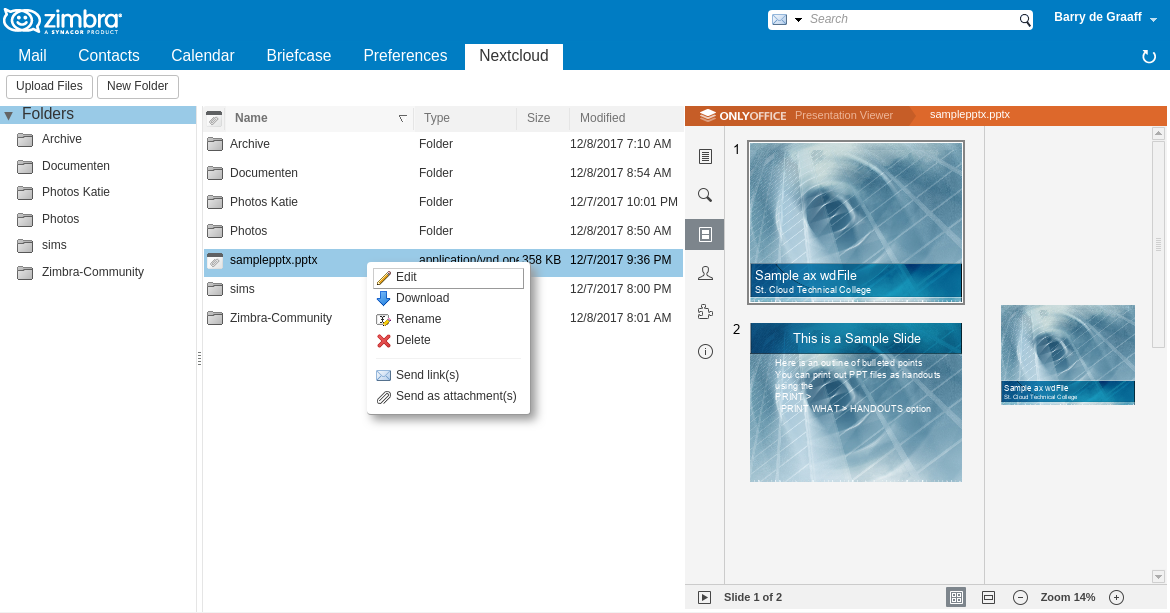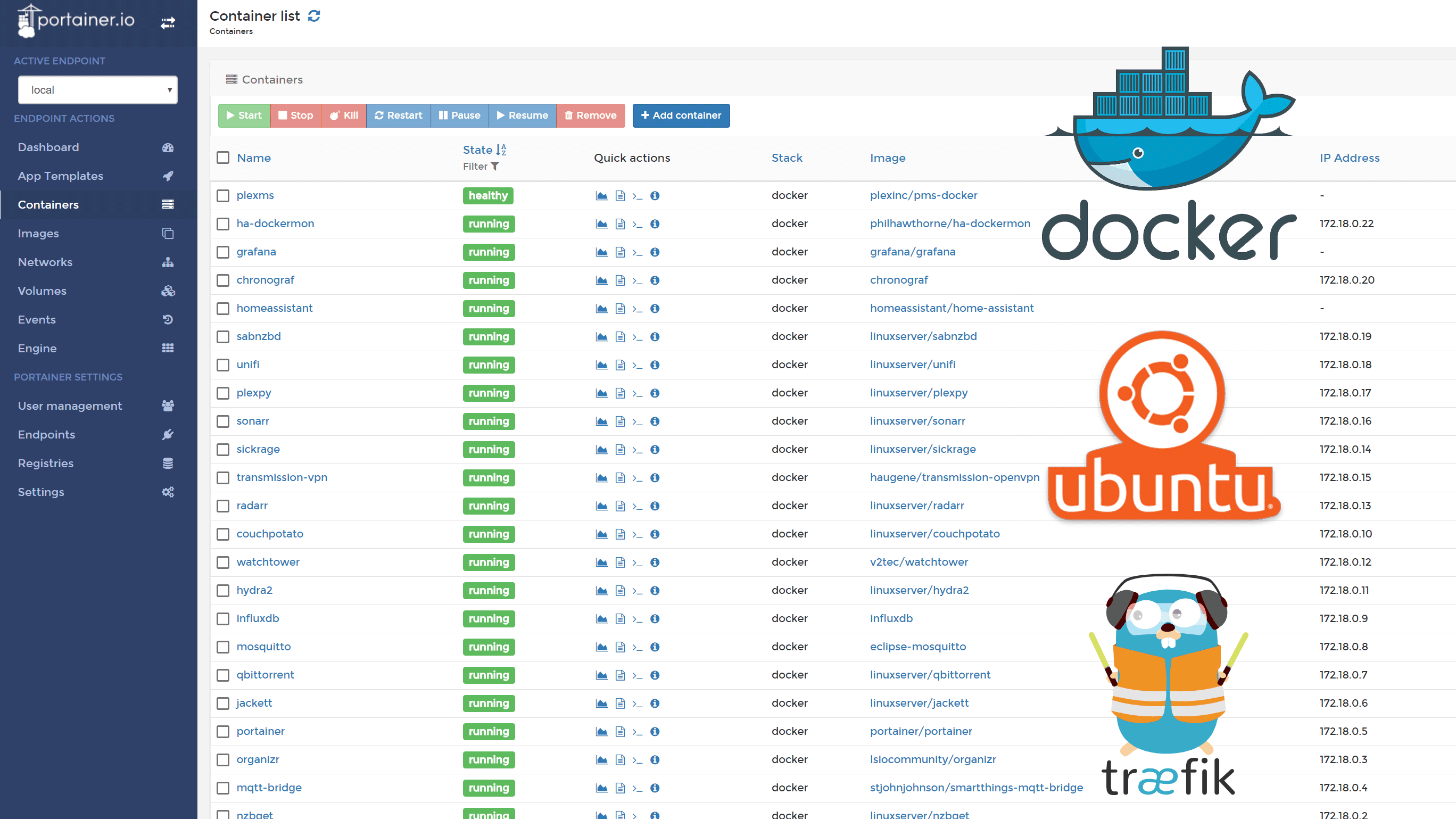装完之后感慨一下,docker大法真好。参考教程 1、烂泥:个人网盘nextcloud的docker化搭建 2、wonderfall/nextcloud 据说比官网好用的环境,可惜不带Collabora Online,还需要手动安装安装过程安装好LNMP安装包后,测试可用. The following steps will download the Collabora Online docker, make sure to replace 'cloud.nextcloud.com' with the host that your own Nextcloud runs on. Also make sure to escape all dots with double backslashes , since this string will be evaluated as a regular expression (and your bash 'eats' the first backslash.).
We'll describe how to get Collabora Online running on your server and how to integrate it into your Nextcloud using the docker image Nextcloud and Collabora built.
To install it the following dependencies are required:
- A host that can run a Docker container
- A subdomain or a second domain that the Collabora Online server can run on
- An Apache server with some enabled modules (NGINX instructions in a blog here)
- A valid SSL certificate for the domain that Collabora Online should run on
- A valid SSL certificate for your Nextcloud
Note: This guide does NOT cover self-signed certificates. If you use a self-signed certificate then you're mostly on your own ;-)
Install the Collabora Online server
Setup using the built-in CODE server
Install the Collabora Online - Built-in CODE Server app from your Nextclouds apps management. This app provides a built-in server with all of the document editing features of Collabora Online. Easy to install, for personal use or for small teams. It is a bit slower than a standalone server and without the advanced scalability features.
Setup using docker
The collabora/code Docker image can be installed to any x86-64 host (e.g. on Linux and Windows 10), and it is fully configurable. For more information about setup and configuration for deployment, please read the CODE Docker page. If you want to try it out quickly, you can set up CODE docker image with file sharing integration in less than 5 minutes in a very basic way, following these instructions: quick tryout with Nextcloud.

The following steps will download the Collabora Online docker, make sure to replace 'cloud.nextcloud.com' with the host that your own Nextcloud runs on. Also make sure to escape all dots with double backslashes (), since this string will be evaluated as a regular expression (and your bash 'eats' the first backslash.) If you want to use the docker container with more than one Nextcloud, you'll need to use 'domain=cloud.nextcloud.com|second.nexcloud.com' instead. (All hosts are separated by |.)
Optionally, you can select the dictionaries you want with:
This way you are not only limited to German, English, Italian, French and Spanish.
That will be enough. Once you have done that the server will listen on 'localhost:9980'. Now we just need to configure the locally installed Apache reverse proxy.
Setup using packages
As an alternative to Docker image, Collabora provide native Linux packages for selected Linux distributions. If you have Debian 8, Debian 9, Ubuntu 16.04, Ubuntu 18.04, CentOS 7 or openSUSE Leap, please read the CODE Linux packages page.
Setting up a reverse proxy and SSL
It is highly recommended to set up a reverse proxy in front of CODE, either you run CODE from Docker, or you use native packages. It is easy, and this way CODE can be reached on standard HTTP or HTTPS ports. We provide sample configuration files for Apache2 and Nginx. If you want SSL, we recommend certificates from Let's Encrypt.
Docker Nextcloud Ssl Command
Now you can give https://collabora.example.com as the WOPI URL in your preferred File Sync and Share solution. See below for specific examples.
Apache guide
On a recent Ubuntu or Debian this should be possible using:
Afterward, configure one VirtualHost properly to proxy the traffic. For security reason we recommend to use a subdomain such as office.nextcloud.com instead of running on the same domain. An example config can be found below:
After configuring these do restart your apache using /etc/init.d/apache2 restart.
Configure the app
You can configure the app either from within Nextcloud itself, or from thecommandline. The latter facilitates automated setup, e.g. via Ansible.
Configure the app in Nextcloud
Go to the Apps section and choose 'Office & text'Install the 'Collabora Online app'Admin -> Collabora Online -> Specify the server you have setup before (e.g. 'https://office.nextcloud.com')
Congratulations, your Nextcloud has Collabora Online Office integrated!
Configure the app from the commandline
From a shell running in the Nextcloud root directory, run the following occcommands, substituting the server url you've setup (e.g. 'https://office.nextcloud.com'):
Docker Nextcloud Ssl
Congratulations, your Nextcloud has Collabora Online Office integrated!
Updating the docker image

Occasionally, new versions of this docker image are released with security and feature updates. We will of course let you know when that happens! This is how you upgrade to a new version:
grab new docker image:
List docker images:
from the output you can glean the Container ID of your Collabora Online docker image.stop and remove the Collabora Online docker image:
start the new image:

Enjoy!
The mini-computer Raspberry Pi is good for more than just playing around or teaching children about hardware and programming. Users have set up web servers on Raspberry Pi, as well as cloud servers using ownCloud. It’s even possible to combine Raspberry Pi and Nextcloud, and some users have built Raspberry Pi mail servers.
Developers have also made the single-board computer their own. Web and software developers have already been using the mini-computer for a while, for example, in order to work with the Internet of Things. It seems high-time then to explore the advantages of Docker on Raspberry Pi.
What challenges are involved in combining Raspberry Pi and Docker?
Most Raspberry Pis run on the official operating system Raspberry Pi OS, which is an adaptation of the Linux distribution Debian. Since Docker has been used successfully for many scenarios on Linux, using it with Raspberry Pi shouldn’t be a problem. However, the differences in the hardware can indeed lead to some problems, as Pi is not just a no-frills version of a PC but uses an entirely different processor architecture.

The operating system Raspberry Pi OS was previously known under the name Raspbian.

Docker is actually based on a x64 system, which is used on most modern computers. But Raspberry Pi uses ARM technology, meaning that normal Docker images aren’t compatible with the instance on Pi. That being said, a growing number of pre-made containers are now available for Raspberry Pi. It’s of the utmost importance that users only download pre-made containers from trustworthy sources in order to avoid unnecessary security risks. Even though there haven’t been a lot of options so far (and, compared with Docker on other systems, there probably won’t be in the near future), you can still get full use out of the system by developing your own container.
The advantages of Docker on Raspberry Pi
If you know your way around computer hardware and Linux, Raspberry Pi is relatively easy to configure. That’s why the small PCs are also used for experiments. The same goes for Docker – the containers are self-contained and so cannot damage the actual system.
Because a Raspberry Pi is relatively affordable to purchase and run, the mini-computers are also a good choice for building a Docker swarm. Instead of constructing a server structure, you can simply get multiple Raspberry Pis and connect them all with one another. Then each device executes its own container. The containers can then be orchestrated with Swarm und Compose.
Small single-board computers like Raspberry Pi are being used more and more often in the context of the Internet of Things thanks to their small size and low costs. When combining Docker and Raspberry Pi you can even get container technology to run on a device that wouldn’t usually be recognized as a computer.
How to install Docker on Raspberry Pi
In the best case scenario, Docker can be installed with Raspberry Pi’s operating system. The Docker team has provided a special installation script for this. The first step involves downloading and executing the script, which you can do using a cURL command.
To make sure that the installation was successful, you can try out the “hello world” image.
If everything is in order, Docker should pull the image from the Internet and execute it. You should get a message from the developer. The image here isn’t the normal “Hello world” image that would run on other systems, but rather an image that was specially made for ARM processors.
In order to protect your privacy, the video will not load until you click on it.
Docker containers are made available by official developers as well as members of the community. To minimize security risks, you should only use containers that are actively maintained and already being used by a good number of users. In the DockerHub you can also find containers that were put together just for Raspberry Pi. The repository also offers the option of only viewing “official images” or containers from “verified publishers”.
Hypriot OS: the all-in-one solution
A small team of developers produced a special operating system for people who want to have a better experience with Docker and Raspberry Pi: Hypriot OS is specially pre-configured for using containers. The operating system is based on Debian, but is kept to a minimum making it perfectly suited to both Raspberry Pi and Docker. The Kernel is also specifically optimized for this purpose. Thanks to the lightweight structure of the system, it’s also possible to run several computers in parallel on relatively inefficient systems.
Nextcloud Docker Ssl Synology
Hypriot OS is installed like other operating systems for Raspberry Pi: First prepare an SD card on another computer with the image of Hypriot. (The operating system can be downloaded for free from the official website or from GitHub.) Then insert the memory card into the Raspberry Pi. When it starts, the computer will then load from the card and run with Hypriot. Using an SSH connection, you can then access the Raspberry Pi from the other computer and use Docker on Raspberry Pi.
Docker Compose Nextcloud Ssl
Regardless of how you bring together Docker and Raspberry Pi, you’ll also have to know how to work with the container software. Learn about the first steps and pick up a lot of important information about Docker in our Docker tutorial.
Docker Nextcloud Enable Ssl
